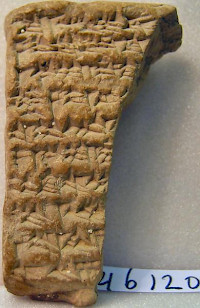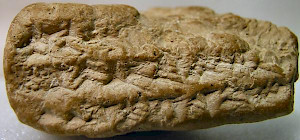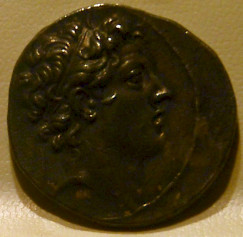BCHP 13 (Politai Chronicle)
The Politai Chronicle (BCHP 13) is one of the Mesopotamian chronicles written in ancient Babylonia in the Hellenistic Period.

The first Babylonian document on the politai (Greek citizens of the city of Babylon) is the Politai Chronicle (BCHP 13), one of the Mesopotamian chronicles written in ancient Babylonia in the Hellenistic Period. (The cuneiform tablet BM 46120 = 81-7-6,572) is in the British Museum. The tablet can be dated to SE 140 (=172/1 BCE) ands belongs, therefore, to the reign of the Seleucid king Antiochus IV Epiphanes (r.175-164).
On this webpage, a new reading is proposed; the official publication will be in I.L. Finkel, R.J. van der Spek, R. Pirngruber, Babylonian Chronographic Texts from the Hellenistic Period (2020; = BCHP; Writings of the Ancient World).
Description of the tablet

Left side of a small, roughly square tablet, covering certain years of the Seleucid era, starting with year 140. Length: 5 cm., width at top: 3 cm., at bottom 1,5 cm. The top and bottom edges are preserved, but the reverse is lost. In size and shape it resembles the Greek Community Chronicle (BCHP 14) (SE 149 = 163/2 BCE) and ABC 9 (= Artaxerxes III chronicle, 345 BCE).
Commentary
This chronicle is the first cuneiform document mentioning the puliṭe, i.e. the Babylonian rendering of the Greek word politai, which probably stands for Greek or Hellenized citizens. Elsewhere I have argued that this Greek colony with special rights was introduced in or shortly before SE 139 = 173/2 BCE.note So far politai were only mentioned in the Astronomical Diaries.
Boiy argues that the first reference to politai in the diaries was in the diary concerning the visit of Antiochus III the Great to Babylon in February 187 BCE (month XI, 124 SEB).note During that visit, the king made offerings in the temple, visited the New Year Temple (Day One Temple) and received (?) the robe of Nebuchadnezzar. It is stated:
That day (4.XI = 14 February 187), the pah[atu (epistatês, governor) [and the politai (?)] presented (pl!) [a … of go]ld to king Antiochus.note

Boiy argues that politai must have been mentioned in the break in view of the fact that pahatu and politai are mentioned very often together in the Astronomical Diaries. The argument is reasonable, but confirmation of the suggestion by other documents is required.
This chronicle is the first non-diary text which mentions the politai. The first certain attestation of politai in the Diaries is the diary of Month V 143 SEB concerning the victories of Antiochus IV Epiphanes in Egypt and the performance of a pompê (procession) by the politai:
That month I heard as follows: King Antiochus marched victoriously through the cities of Egypt. The politai (pu-li-te-e) [established] a pompê (pu-up-pe-e) and a ritual in the Greek fashion.note
Antiochus IV conquered Egypt in the summer of 169 BC and the news of his victories reached Babylon in month Abu (V), 143 SEB = 17 August- 15 September, 169 BC (= month XI [Gorpiaios] 143 SEM).
See for more information the Greek Community Chronicle (BCHP 14).
Obverse
[Obv.1] Year 140, Simanu (month III = 24 May-22 June 172 BCE) [.. .. .. .. ..]
[Obv.2] of/which the politai [.. .. .. .. ..]
[Obv.3] opposite the Great Gate [.. .. .. .. .. ..]
[Obv.4] Bricks of the [.. .. ..] house [.. .. ..]
[Obv.5] That day, in x [.. .. .. .. .. ..]
[Obv.6] which opposite the [.. .. ..] Ga[te .. .. ..]
[Obv.7] Weeping in x[ .. .. .. .. .. ..]
[Obv.8] Year 14[1? .. .. .. .. .. ..]
[Obv.9] of the debris [.. .. .. .. .. .. ..]
[Obv.10] Day 25 [th .. .. .. .. .. ..]
[Obv.11] [.. .. .. .. .. .. .. .. .. .. ..] x
Bottom edge
[Bottom edge.12] [.. .. ..] x [.. .. .. .. .. .. ]
[Bottom edge.13] [.. .. ..] x x [ .. .. .. .. .. ]
[Bottom edge.14] [.. .. .. ] x [.. ] x [ .. .. .. .. ]
Reverse
[Rev] [Lost]
Upper edge
[Upper edge.1] Ajaru (month II), (day) 23 x x x […land]
[Upper edge.2] planted with palmtrees and balks? [.. .. ..]
[Upper edge.3] through works? they went? […]